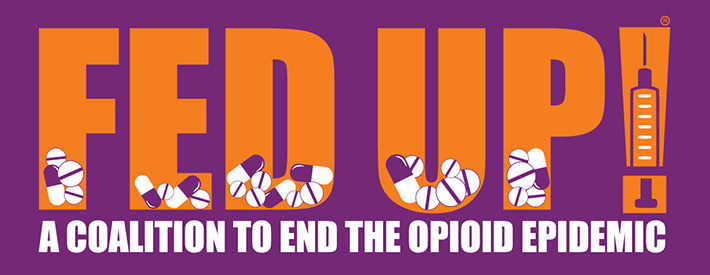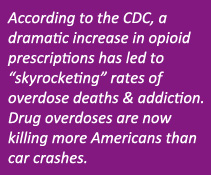The long delay since the last Advocacy Update does not reflect the pace of activities in the opioid addiction epidemic or in FED UP!
The terrible news that came in December was a shocking 27.7% increase in opioid overdose deaths. 350,000 Americans have now died of opioid overdose deaths since the epidemic began in 1999. Between 2015 and 2016, deaths due to fentanyl and analogues more than doubled from 9,945 to 20,145, and more opioid deaths in 2016 involved fentanyl than either prescription opioids or heroin. Fentanyl is 50-100 times stronger than heroin, and users have no way to know how much fentanyl has been added to their heroin, or whether their entire heroin dose is in fact fentanyl. Heroin has always been a dangerous drug, but as fentanyl-laced heroin became common, the death rate for heroin users tripled.
Despite encouraging words and the declaration of a Public Health Emergency, the Trump administration has done very little about the opioid addiction epidemic. The new Trump Budget looks promising but is so far only a broad outline.
Under these circumstances, the work of FED UP! has become more important than ever.
We continue to struggle against the powerful influence of the pharmaceutical industry. We are proud to let you know that the website www.pharmedout.org has recognized FED UP! as one of the small percentages of health advocacy groups in the U.S. that are completely independent of pharmaceutical industry money.
We have joined together with Facing Addiction with NCADD to form a new coalition working to hold the pharmaceutical industry accountable. Together we’ve launched the #BillionsNotMillions campaign. The pharmaceutical industry has made roughly $200 billion in profits from prescription opioid sales since 1999. More than 250 cities, towns, states, hospitals, labor unions, and Native American tribes have filed lawsuits against opioid manufacturers and distributors for their roles in creating the opioid addiction epidemic. These multiple cases have been combined and are being heard before a federal judge in Cleveland. The coalition is concerned that the settlement will be far less than it should be. Together, our coalition supports the type of settlement that was reached with Big Tobacco. We believe that the pharmaceutical industry has a duty to contribute to solutions to the terrible epidemic of addiction and its consequences that have been spawned by their (1) overstating the benefits of prescription opioids (2) downplaying the risks of opioid use, (3) aggressively marketing these drugs to physicians, and (4) failing to monitor, refuse, and report suspicious orders of prescription opioids as required by law. The lawsuits should be settled in a way that will bring desperately-needed funds to communities to address the problems which have resulted from the behavior of the pharmaceutical industry.
FED UP! has continued to maintain a very active role within FDA as prescription opioids continue to fuel the opioid addiction crisis. While there has been a meaningful decrease in opioid prescribing, down from 782 MME per person in 2010 to 599 MME in 2016, the level of opioid prescribing is far above historical norms: 82 MME per capita in 1997; 180 MME per capita in 1999.
We feel we are seeing a meaningful shift in emphasis at the FDA. The FDA called for a report from the National Academy of Sciences (NAS) on analyzing risks and benefits of prescription opioids. The NAS report suggests that the FDA must use a new risk-benefit framework for full consideration of health effects of opioid misuse and not limit itself to the paradigm of “safe if taken as prescribed.”
As we reported in our last Advocacy Update, FED UP! joined with Physicians for Responsible Opioid Prescribing, Shatterproof, the National Safety Council and ASTHO (the organization for state health commissioners) to submit a Citizen Petition to the FDA to eliminate ultra high dose unit (UHDU) opioids. UHDU opioids are those which, when take as directed, exceed the 90 MME (mg of morphine equivalents) dose the CDC regards as dangerously high. The public comment period ended Feb. 28, and we are now awaiting FDA response.
The FDA has appointed a new Opioid Steering Committee, which has met twice since our last Advocacy Update. FED UP! has been active in recommending that:
- FDA should overhaul its opioid policies in line with the National Academy of Sciences report;
- FDA should prohibit drug companies from promoting long-term use of opioids as safe and effective for chronic pain;
- FDA should remove dangerous ultra-high dosage opioids from the market;
- FDA should stop approving new opioids- we can’t handle the ones we have now;
- FDA should make education about addiction mandatory for prescribers who want to give more than a 3-day supply of opioids.
FED UP! members gave formal presentations at the February meeting of the Opioid Steering Committee regarding the FDA’s new REMS (Risk Evaluation and Mitigation Strategies) proposals for prescription opioids.
Addendum, April 8, 2018:
Before we could release this Advocacy Update, the Omnibus Appropriations Act became law. The increase in funding from $ 1 billion to $ 4 billion indicates bipartisan recognition of the severity of the opioid addiction epidemic. The Trump Administration has made it clear that it intends for funding in 2019 to be no lower than in 2018. These are significant steps.
The Federal agencies involved are actively engaged in determining how the appropriated money will be spent.
Unfortunately, we continue to be concerned as to whether this money will actually be available for those who need it. The President continues to call for massive reductions in health care spending. Funding for a large percentage of those needing opioid addiction treatment depends on public aid. If the Administration succeeds in its health care proposals, the entire gain in addiction treatment availability would be wiped out. We need to make sure this does not happen.
A second concern we have is the lack of certainty as to future funding. Those who develop and participate in programs to be funded this year need to know that federal funding will not suddenly disappear in the near future. We would like to see a federal commitment for the next 10 years to assure continuity of programming.
A set of priorities in the use of the appropriated funds has been developed by a bipartisan congressional group. Their proposed legislation is called CARA 2.0. We are in strong agreement with most of the proposals in CARA 2.0.
If passed as currently written, CARA 2.0 would:
- Place a 3 day limit on initial opioid prescriptions for acute pain, as recommended by the Centers for Disease Control and Prevention (CDC).
- Make permanent Section 303 of CARA which allows physician assistants and nurse practitioners to prescribe buprenorphine under the direction of a qualified physician.
- Allow states to waive the limit on the number of patients a physician can treat with buprenorphine so long as they follow evidence-based guidelines. There is currently a cap of 100 patients per physician or 275 patients per physician for those who have prescribed to 100 patients for at least one year.
- Require physicians and pharmacists use their state PDMP prior to prescribing or dispensing opioids.
- Increase civil and criminal penalties for opioid manufacturers that fail to report suspicious orders for opioids or fail to maintain effective controls against diversion of opioids.
- Create a national standard for recovery residences to ensure quality housing for individuals in long-term recovery.
There are two changes we would like to see in CARA 2.0:
- The cap on penalties for opioid manufacturers and distributors, although increased, makes the decision of whether to report inappropriate opioid orders a decision based on profit: if the potential profit is greater than the maximum fine, it may be in the economic interests of the pharmaceutical manufacturing and distribution industries to look the other way when inappropriate opioid orders are received. Caps on fines should be removed.
- We applaud legislation which would end caps on the number of patients receiving buprenorphine from a single physician. However, the number of physicians prescribing buprenorphine remains low. The required 8-hour training course constitutes a disincentive to becoming a buprenorphine prescriber. It is our belief that the 8-hour requirement is arbitrary and excessive and could be reduced substantially without compromising the quality of care.







